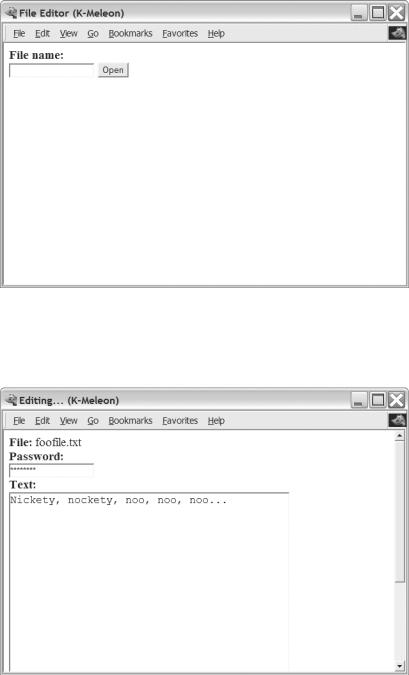
Beginning Python - From Novice To Professional (2005)
.pdf
C H A P T E R 2 5 ■ P R O J E C T 6 : R E M O T E E D I T I N G W I T H C G I |
481 |
3.Edit the file to taste, enter the password (one you’ve set yourself, or the one used in the example, which is “foobar”), and click Save. Your browser should then contain the output of the save.cgi script, which is simply the message “The file has been saved.”
4.If you want to verify that the file has been modified, you may repeat the process of opening the file (Steps 1 and 2).
Further Exploration
With the techniques shown in this project, you can develop all kinds of Web systems. Some possible additions to the existing system are as follows:
•Version control: Save old copies of the edited file so you can “undo” your changes.
•Add support for user names so you know who changed what.
•Add file locking (for example, with the fcntl module) so two users can’t edit the file at the same time.
•Add a view.cgi script that automatically adds markup to the files (like the one in Chapter 20).
•Make the scripts more robust by checking their input more thoroughly and adding more user-friendly error messages.
•Avoid printing a confirmation message like “The file has been saved.” You can either add some more useful output, or redirect the user to another page/script. Redirection can be done with the Location header, which works like Content-type. Just add Location: followed by a space and a URL to the header section of the output (before the first empty line).
In addition to expanding the capabilities of this CGI system, you might want to check out some more complex Web environments for Python (as discussed in Chapter 15).
What Now?
Now you’ve tried your hand at writing CGI scripts. In the next project, you expand on that by using an SQL database for storage. With that powerful combination, you’ll implement a fully functional Web-based bulletin board.

484 C H A P T E R 2 6 ■ P R O J E C T 7 : Y O U R O W N B U L L E T I N B O A R D
•Posting new messages
•Replying to existing messages
In addition to these functional requirements, it would be nice if the system was reasonably stable, could handle a large number of messages, and avoided such problems as two users writing to the same file at the same time. The desired robustness can be achieved by using a database server of some sort, instead of writing the file-handling code yourself.
Useful Tools
In addition to the CGI stuff from Chapter 15, you’ll need an SQL database, as discussed in Chapter 13. You could either use the stand-alone database SQLite, which is used in that chapter, or you could use some other system, such as either of the following two excellent, freely available databases:
•PostgreSQL (http://www.postgresql.org)
•MySQL (http://www.mysql.org)
In this chapter, I use PostgreSQL for the examples, but the code should work with most SQL databases (including MySQL) with few edits.
Before moving on, you should make sure that you have access to an SQL database server and check its documentation for instructions on how to manage it.
In addition to the database server itself, you’ll need a Python module that can interface with the server (and hide the details from you). Most such modules support the Python DB-API, which is discussed in more detail in Chapter 13. In this chapter, I use psycopg (http://initd.org/ Software/psycopg), a robust front-end for PostgreSQL. If you’re using MySQL, the MySQLdb module (http://sourceforge.net/projects/mysql-python) is a good choice.
After you have installed your database module, you should be able to import it without raising any exceptions. For psycopg:
>>>import psycopg
For MySQLdb:
>>>import MySQLdb
You get the idea.
Preparations
Before your program can start using your database, you have to actually create the database. That is done using SQL (see Chapter 13 for some pointers on this).
The database structure is intimately linked with the problem and can be a bit tricky to change once you’ve created it and populated it with data (messages). Let’s keep it simple: You’ll have only one table, which will contain one row for each message. Each message will have a unique ID (an integer), a subject, a sender (or poster), and some text (the body).
C H A P T E R 2 6 ■ P R O J E C T 7 : Y O U R O W N B U L L E T I N B O A R D |
485 |
In addition, because you want to be able to display the messages hierarchically (threading), each message should store a reference to the message it is a reply to. The resulting CREATE TABLE SQL command is shown in Listing 26-1.
Listing 26-1. Creating the Database in PostgreSQL
CREATE TABLE messages (
id |
SERIAL PRIMARY KEY, |
subject |
TEXT NOT NULL, |
sender |
TEXT NOT NULL, |
reply_to |
INTEGER REFERENCES messages, |
text |
TEXT NOT NULL |
); |
|
Note that this command uses some PostgreSQL-specific features (serial, which ensures that each message automatically receives a unique ID, the text data type, and references, which makes sure that reply_to contains a valid message ID). A more MySQL-friendly version is shown in Listing 26-2.
Listing 26-2. Creating the Database in MySQL
CREATE TABLE messages (
id |
INT NOT NULL AUTO_INCREMENT, |
subject |
VARCHAR(100) NOT NULL, |
sender |
VARCHAR(15) NOT NULL, |
reply_to |
INT, |
text |
MEDIUMTEXT NOT NULL, |
PRIMARY KEY(id)
);
I’ve kept these code snippets simple (an SQL guru would certainly find ways to improve them) because the focus of this chapter is, after all, the Python code. The SQL statements create a new table with the following five fields (columns):
id: Used to identify the individual messages. Each message automatically receives a unique id by the database manager, so you don’t have to worry about assigning those from your Python code.
subject: A string that contains the subject of the message.
sender: A string that contains the sender’s name or e-mail address or something like that.
reply_to: If the message is a reply to another message, this field contains the id of the other message. (Otherwise, the field won’t contain anything.)
text: A string that contains the body of the message.
When you’ve created this database and set the permissions on it so that your Web server is allowed to read its contents and insert new rows, you’re ready to start coding the CGI.

486 C H A P T E R 2 6 ■ P R O J E C T 7 : Y O U R O W N B U L L E T I N B O A R D
First Implementation
In this project, the first prototype will be very limited. It will be a single script that uses the database functionality so that you can get a feel for how it works. Once you’ve got that pegged, writing the other necessary scripts won’t be very hard. In many ways, this is just a short reminder of the material covered in Chapter 13.
The CGI part of the code is very similar to that in Chapter 25. If you haven’t read that chapter yet, you might want to take a look at it. You should also be sure to review the section “CGI Security Risks” in Chapter 15.
■Caution In the CGI scripts in this chapter, I’ve imported and enabled the cgitb module. This is very useful to uncover flaws in your code, but you should probably remove the call to cgitb.enable before deploying the software—you probably wouldn’t want an ordinary user to face a full cgitb traceback.
The first thing you need to know is how the DB API works. If you haven’t read Chapter 13, you probably should at least skim through it now. If you’d rather just press on, here is the core functionality again (replace db with the name of your database module—for example, psycopg or MySQLdb):
conn = db.connect('user=foo dbname=bar'): Connects to the database named bar as user foo and assigns the returned connection object to conn. (Note that the parameter to connect is a string.)
■Caution In this project, I assume that you have a dedicated machine on which the database and Web server run. The given user (foo) should only be allowed to connect from that machine to avoid unwanted access. If you have other users on your machine, you should probably protect your database with a password, which may also be supplied in the parameter string to connect. To find out more about this, you should consult the documentation for your database (and your Python database module).
curs = conn.cursor(): Gets a cursor object from the connection object. The cursor is used to actually execute SQL statements and fetch the results.
conn.commit(): Commits the changes caused by the SQL statements since the last commit.
conn.close(): Closes the connection.
curs.execute(sql_string): Executes an SQL statement.
curs.fetchone(): Fetches one result row as a sequence—for example, a tuple.
curs.dictfetchone(): Fetches one result row as a dictionary. (Not part of the standard, and therefore not available in all modules.)
curs.fetchall(): Fetches all result rows as a sequence of sequences—for example, a list of tuples.
C H A P T E R 2 6 ■ P R O J E C T 7 : Y O U R O W N B U L L E T I N B O A R D |
487 |
curs.dictfetchall(): Fetches all result rows as a sequence (for example, a list) of dictionaries. (Not part of the standard, and therefore not available in all modules.)
Here is a simple test (assuming psycopg)—retrieving all the messages in the database (which is currently empty, so you won’t get any):
>>>import psycopg
>>>conn = psycopg.connect('user=foo dbname=bar')
>>>curs = conn.cursor()
>>>curs.execute('SELECT * FROM messages')
>>>curs.fetchall()
[]
Because you haven’t implemented the Web interface yet, you have to enter messages manually if you want to test the database. You can do that either through an administrative tool (such as mysql for MySQL or psql for PostgreSQL), or you can use the Python interpreter with your database module.
Here is a useful piece of code you can use for testing purposes:
# addmessage.py
import |
psycopg |
|
conn |
= |
psycopg.connect('user=foo dbname=bar') |
curs |
= |
conn.cursor() |
reply_to = raw_input('Reply to: ') subject = raw_input('Subject: ') sender = raw_input('Sender: ') text = raw_input('Text: ')
if reply_to: query = """
INSERT INTO messages(reply_to, sender, subject, text)
VALUES(%s, '%s', '%s', '%s')""" % (reply_to, sender, subject, text) else:
query = """
INSERT INTO messages(sender, subject, text) VALUES('%s', '%s', '%s')""" % (sender, subject, text)
curs.execute(query)
conn.commit()
Note that this code is a bit crude—it doesn’t keep track of IDs for you (you’ll have to make sure that what you enter as reply_to, if anything, is a valid ID), and it doesn’t deal properly with text containing single quotes (this can be problematic because single quotes are used as string delimiters in SQL). These issues will be dealt with in the final system, of course.
Try to add a few messages and examine the database at the interactive Python prompt— if everything seems okay, it’s time to write a CGI script that accesses the database.
488 C H A P T E R 2 6 ■ P R O J E C T 7 : Y O U R O W N B U L L E T I N B O A R D
Now that you’ve got the database handling code figured out and some ready-made CGI code you can pinch from Chapter 25, writing a script for viewing the message subjects (a simple version of the “main page” of the forum) shouldn’t be too hard. You must do the standard CGI setup (in this case, mainly printing the Content-type string), do the standard database setup (get a connection and a cursor), execute a simple SQL select command to get all the messages, and then retrieve the resulting rows with curs.fetchall or curs.dictfetchall.
Listing 26-3 shows a script that does these things. The only really new stuff in the listing is the formatting code, which is used to get the threaded look where replies are displayed below and to the right of the messages they are replies to.
It basically works like this:
1.For each message, get the reply_to field. If it is None (not a reply), add the message to the list of top-level messages. Otherwise, append the message to the list of children kept in children[parent_id].
2.For each top-level message, call format.
The format function prints the subject of the message. Also, if the message has any children, it opens a blockquote element (HTML), calls format (recursively) for each child, and ends the blockquote element.
If you open the script in your Web browser (see Chapter 15 for information on how to run CGI scripts), you should see a threaded view of all the messages you’ve added (or their subjects, anyway).
For an idea of what the bulletin board looks like, see Figure 26-1 later in this chapter.
Listing 26-3. The Main Bulletin Board (simple_main.cgi)
#!/usr/bin/python
print 'Content-type: text/html\n'
import |
cgitb; cgitb.enable() |
|
import |
psycopg |
|
conn |
= |
psycopg.connect('dbname=foo user=bar') |
curs |
= |
conn.cursor() |
print """
<html>
<head>
<title>The FooBar Bulletin Board</title> </head>
<body>
<h1>The FooBar Bulletin Board</h1>
"""

